planning to be here for au/prompt needs. submit your ideas! fuelling fanfictions (and other stuff) is what i do.
Don't wanna be here? Send us removal request.
Text
dialogue prompt #2
“Okay, look. I know you desperately need groceries or whatever, but we’re closed, and I’d very much so like to go home.”
8 notes
·
View notes
Text
after dying god informs you that hell is a myth, and “everyone sins, its ok”. instead the dead are sorted into six “houses of heaven” based on the sins they chose.
287K notes
·
View notes
Text
person a: look me in the eye and tell me you prefer cupcakes over muffins
person b: i prefer cupcakes over muffins
a: ...
b: ...
a: *agressively whispering* cupcakes are just fancy muffins
1 note
·
View note
Text
some fucking resources for all ur writing fuckin needs
body language masterlist
a translator that doesn’t eat ass like google translate does
a reverse dictionary for when ur brain freezes
550 words to say instead of fuckin said
638 character traits for when ur brain freezes again
some more body language help
259K notes
·
View notes
Text
Some words to use when writing things:
winking
clenching
pulsing
fluttering
contracting
twitching
sucking
quivering
pulsating
throbbing
beating
thumping
thudding
pounding
humming
palpitate
vibrate
grinding
crushing
hammering
lashing
knocking
driving
thrusting
pushing
force
injecting
filling
dilate
stretching
lingering
expanding
bouncing
reaming
elongate
enlarge
unfolding
yielding
sternly
firmly
tightly
harshly
thoroughly
consistently
precision
accuracy
carefully
demanding
strictly
restriction
meticulously
scrupulously
rigorously
rim
edge
lip
circle
band
encircling
enclosing
surrounding
piercing
curl
lock
twist
coil
spiral
whorl
dip
wet
soak
madly
wildly
noisily
rowdily
rambunctiously
decadent
degenerate
immoral
indulgent
accept
take
invite
nook
indentation
niche
depression
indent
depress
delay
tossing
writhing
flailing
squirming
rolling
wriggling
wiggling
thrashing
struggling
grappling
striving
straining
1M notes
·
View notes
Text
Sword Fighting For Fic Writers: Chapter 13
You can follow the tag #Swords for Fics if you want to keep up without following me :)
Available Chapters: 1.Dumb Ways to Die 2.May Your Blade Be True! 3.On Your Guard! 4. Making the Cut 5.Stick ‘em With the Pointy End 6.It’s Like a Dance 7. The Measure of A Man 8.A Crossing of Blades 9.Like Chess, but with Knives An Interlude About Story Telling 10.You Can Barely Lift Your Sword 11.Buckle Some Swash 12.Dual Wielding 13.Everything is a Weapon 14.Got Your Sword
Your Body Everything is a Weapon Punching, Throwing, and Other Things
Up until now you may have noticed that with one handed swords I draw the free hand tucked in behind the fighter’s back. That wasn’t just me trying to avoid drawing more hands. If you’re not using that arm in a fight, it’s better to keep it back and out of the way rather than making it another target. I’ve also seen it placed on the hip in case it becomes needed, or just waving around in the back. In this chapter we’ll talk about ways that free hand can help. We’ll also be covering throwing the opponent down, and using the pommel of the sword.
Using Your Free Hand:
-Punching Most of the time it’s going to be more practical and efficient to use the sword to make an attack. There will be times though when the defender’s sword is restrained and the attacker doesn’t want to kill their opponent that they may go for a punch. Or maybe they just see an opening and say to hell with it. For your narrative, do whatever feels badass. When defending against fist attacks with your own arm, you’re essentially doing the same thing as you do with your sword. Use the “true edge” of your arm to block then counter attack.
-Grabbing It may seem stupid to grab your opponent’s sword by the blade, but it’s a thing. Swords aren’t lightsabers. You can grab them. There are ways to safely do this without cutting yourself. Other times it’ll just be better to take a shallow cut on the hand to finish the fight. Typically grabs will be done against a blade that’s not in motion. You’re not going to catch a swinging blade. Gloves and gauntlets make grabbing even safer. The sword arm is another thing to grab to control their weapon. Grabs can be turned into disarms. More on that in “Got Your Sword!” (chapter coming soon)

Kicking: I myself have not encountered kicking in fights so take this with some salt. If it happens it probably happens mostly in grappling range. Kicking your foot out without the opponent’s sword controlled is sticking a big target out there. If you don’t throw them off balance enough with the move you’ll be vulnerable while you reset. But for narrative purposes, you can stick with the rule of cool: if it’s cool, go or it!
Using the Pommel: Using the pommel to strike is a good method of dealing a non-lethal blow. It’s most easily done after a yield (see “A Crossing of Blades”). Instead of continuing to spin the blade around, the blade stops it’s turn with the sword pointing down, then rams into the opponent’s face with the back end of the sword. There’s also a way to use the hilt to hook the opponent’s weapon into a disarm. More on that in “Got Your Sword”.
Throwing: To throw an opponent first you need to get close to them. Let’s assume that’s been done. Maybe you stepped in during an attack or defense and they didn’t step back. First break their structure to set them off balance by pushing into their face. Pushing up under the chin is especially helpful, lifting them up a bit as well as pushing them back. If you’re pushing with your right arm then your right leg steps behind them, pushing your hip into theirs. Now turn then beg the legs. Turning will push them back over your leg, tripping them. Even a small person can take out a bigger person like this. The key thing to remember is that if you’re set up to throw them, they can turn it around and throw you instead by getting their leg behind your’s. So be quick about unbalancing them.
Here’s just one version of a throw. Another version is done with the opponents facing each other. Another involves lifting the victim’s leg. Some throws involve using your weapon as leverage, pushing the hilt to break their structure.

Cloaks and Capes: This is another area I’m not personally experienced in and would encourage you to look up if it appeals to you. But so that you know the option is available, capes were often used for defences with things like grabbing swords with the hand protected by the cape, or tangling the opponents sword. Sometimes it was used just as a decoy to cover movements like a matador. Look it up sometime if your fighter wears a cape. They don’t just look cool and keep you warm.
Literally Anything: Think Jackie Chan. Literally anything can be used as a weapon with a little creativity. Swing a bike at people, throw things, kick up dirt, bite, push over bookshelves. Take a look at the environment. Maybe throw a chair in your attacker’s path as you back away making them stumble. Maybe the hero opens the coral of an angry bull the moment they look to be cornered. There’s a low hanging branch to be pulled back and slapped forward. There’s a cliff to corner them on or a wall to push them up against. Carpets can be pulled out from under people’s feet. Hot tea! Pepper! Sink holes! Go nuts!
3K notes
·
View notes
Text
Writing Traumatic Injuries References
So, pretty frequently writers screw up when they write about injuries. People are clonked over the head, pass out for hours, and wake up with just a headache… Eragon breaks his wrist and it’s just fine within days… Wounds heal with nary a scar, ever…
I’m aiming to fix that.
Here are over 100 links covering just about every facet of traumatic injuries (physical, psychological, long-term), focusing mainly on burns, concussions, fractures, and lacerations. Now you can beat up your characters properly!
General resources
WebMD
Mayo Clinic first aid
Mayo Clinic diseases
First Aid
PubMed: The source for biomedical literature
Diagrams: Veins (towards heart), arteries (away from heart) bones, nervous system, brain
Burns
General overview: Includes degrees
Burn severity: Including how to estimate body area affected
Burn treatment: 1st, 2nd, and 3rd degrees
Smoke inhalation
Smoke inhalation treatment
Chemical burns
Hot tar burns
Sunburns
Incisions and Lacerations
Essentials of skin laceration repair (including stitching techniques)
When to stitch (Journal article–Doctors apparently usually go by experience on this)
More about when to stitch (Simple guide for moms)
Basic wound treatment
Incision vs. laceration: Most of the time (including in medical literature) they’re used synonymously, but eh.
Types of lacerations: Page has links to some particularly graphic images–beware!
How to stop bleeding: 1, 2, 3
Puncture wounds: Including a bit about what sort of wounds are most likely to become infected
More about puncture wounds
Wound assessment: A huge amount of information, including what the color of the flesh indicates, different kinds of things that ooze from a wound, and so much more.
Home treatment of gunshot wound, also basics More about gunshot wounds, including medical procedures
Tourniquet use: Controversy around it, latest research
Location pain chart: Originally intended for tattoo pain, but pretty accurate for cuts
General note: Deeper=more serious. Elevate wounded limb so that gravity draws blood towards heart. Scalp wounds also bleed a lot but tend to be superficial. If it’s dirty, risk infection. If it hits the digestive system and you don’t die immediately, infection’ll probably kill you. Don’t forget the possibility of tetanus! If a wound is positioned such that movement would cause the wound to gape open (i.e. horizontally across the knee) it’s harder to keep it closed and may take longer for it to heal.
Broken bones
Types of fractures
Setting a broken bone when no doctor is available
Healing time of common fractures
Broken wrists
Broken ankles/feet
Fractured vertebrae: Neck (1, 2), back
Types of casts
Splints
Fracture complications
Broken noses
Broken digits: Fingers and toes
General notes: If it’s a compound fracture (bone poking through) good luck fixing it on your own. If the bone is in multiple pieces, surgery is necessary to fix it–probably can’t reduce (“set”) it from the outside. Older people heal more slowly. It’s possible for bones to “heal” crooked and cause long-term problems and joint pain. Consider damage to nearby nerves, muscle, and blood vessels.
Concussions
General overview
Types of concussions 1, 2
Concussion complications
Mild Brain Injuries: The next step up from most severe type of concussion, Grade 3
Post-concussion syndrome
Second impact syndrome: When a second blow delivered before recovering from the initial concussion has catastrophic effects. Apparently rare.
Recovering from a concussion
Symptoms: Scroll about halfway down the page for the most severe symptoms
Whiplash
General notes: If you pass out, even for a few seconds, it’s serious. If you have multiple concussions over a lifetime, they will be progressively more serious. Symptoms can linger for a long time.
Character reaction:
Shock (general)
Physical shock: 1, 2
Fight-or-flight response: 1, 2
Long-term emotional trauma: 1 (Includes symptoms), 2
First aid for emotional trauma
Treatment (drugs)
WebMD painkiller guide
Treatment (herbs)
1, 2, 3, 4
Miscellany
Snake bites: No, you don’t suck the venom out or apply tourniquettes
Frostbite
Frostbite treatment
Severe frostbite treatment
When frostbite sets in: A handy chart for how long your characters have outside at various temperatures and wind speeds before they get frostbitten
First aid myths: 1, 2, 3, 4, 5 Includes the ones about buttering burns and putting snow on frostbite.
Poisons: Why inducing vomiting is a bad idea
Poisonous plants
Dislocations: Symptoms 1, 2; treatment. General notes: Repeated dislocations of same joint may lead to permanent tissue damage and may cause or be symptomatic of weakened ligaments. Docs recommend against trying to reduce (put back) dislocated joint on your own, though information about how to do it is easily found online.
Muscular strains
Joint sprain
Resuscitation after near-drowning: 1, 2
Current CPR practices: We don’t do mouth-to-mouth anymore.
The DSM IV, for all your mental illness needs.
Electrical shock
Human response to electrical shock: Includes handy-dandy voltage chart
Length of contact needed at different voltages to cause injury
Evaluation protocol for electric shock injury
Neurological complications
Electrical and lightning injury
Cardiac complications
Delayed effects and a good general summary
Acquired savant syndrome: Brain injuries (including a lightning strike) triggering development of amazing artistic and other abilities
Please don’t repost! You can find the original document (also created by me) here.
127K notes
·
View notes
Photo
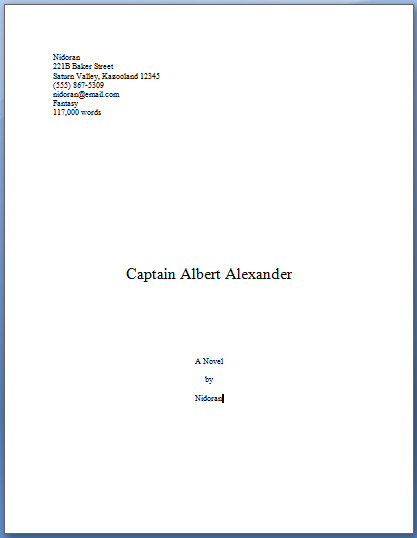
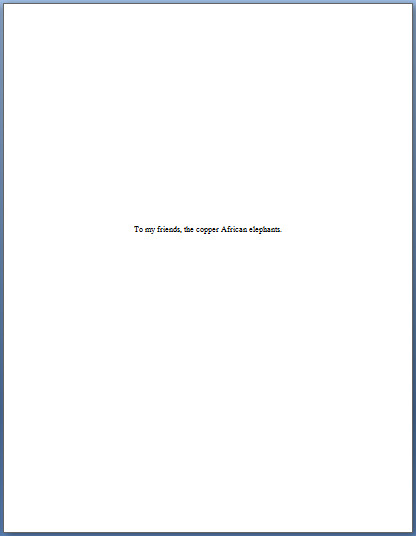

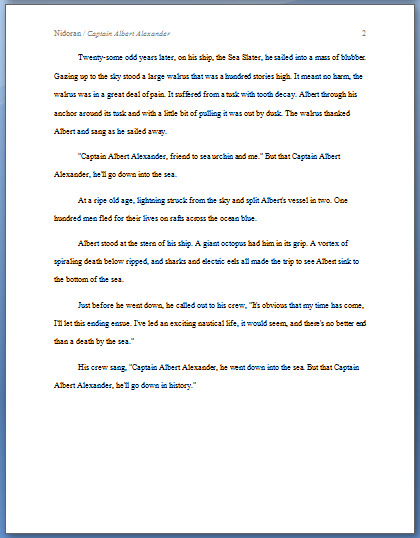
Formatting your Manuscript
If you’re planning on one day turning your manuscript in to literary agents and publishing houses, you need to make sure it’s formatted correctly. In many cases, your manuscript will be skipped over if it isn’t done to industry standard, so here’s the basics that you’ll need if you don’t want to be ignored. Before I get started, please know that this is aimed specifically at fiction manuscripts. If you’re writing non-fiction or a memoir, the expectations will be different, so it would be wise to Google what you need.
The Basics
Make sure your font is 12 point Times New Roman, Courier New, or Arial. These are the only three fonts you are allowed to pick from.
Your spacing should be 1 inch on all sides of the text. This is the default on most word processors, but double check your settings just to be sure.
Your text should be double spaced.
All of your indentations must be a half inch. Do not press indent. Instead, drag over the top arrow on the ruler to have every new paragraph automatically indent.
The Title Page
The top left-hand corner of your title page will have all your personal information. They want to see your name, address, phone number, e-mail address, the novel’s genre, and word count.

Your novel’s title is allowed to be between 20-24 point font if you want. Bold is also an option, but not necessary.
The title will appear halfway down the title page.
“A novel by [your name]” will be about three quarters of the way down the page.
The Next Pages
If you have a dedication, it will be on its own page.
If you have some sort of verse or quote, those will also need their own pages.
Do not include a page for acknowledgements.
The Chapters
Chapter titles will be 12 point font. No bolding or italics.
Chapters will start from one quarter to halfway down the page.
An easy way to format chapter headings is to press enter five or six times
Make sure you always start your chapters the same way every time.
When you start a new chapter, make sure you use a page break to bump the new chapter onto a new page. This will keep it in place so that it will never budge, no matter how much you cut out or add to the previous chapter.
Page Numbers
Page numbers will start with 1 on Chapter 1 of your manuscript. Page numbers will not appear on the title page or dedication page.
Page 1 will be labeled in the footer of Chapter 1. It should be centered.
Page 2 will be in the header of the next page.
From page 2 onward, your headers will be labeled like this:

If you insert a section break after the title and dedication pages, it will make it easier to insert the page numbers.
For the most part, this is the most important of what you’ll need to know for formatting your manuscript. I used this video as reference, so I’m trusting everything it says is true because it was made by an author who has several novels published, and because it was uploaded this year, it should be up to date.
But just remember, whenever you go to turn in a manuscript, make sure you check the website of the agent or publisher you’re trying to contact. They might have specifications that differ with the ones stated in this video, and you should always do whatever you can to abide by what they want.
74K notes
·
View notes
Text
Commonly Used Words and their Synonyms!
Instead of using… You can use the word…
Looked — observed, peered, gazed, glanced, explored, glimpsed, stared, eyed, viewed, noticed, watched, inspected, examined, and peeked.
Said — told, stated, replied, phrased, announced, articulated, reported, expressed, voiced, mentioned, communicated, uttered, spoke, and vocalised.
Shouted — yelled, roared, exclaimed, hollered, cried, called out, squealed, wailed, screeched, squawked, bellowed, shrieked, screamed, and howled.
Laughed — chuckled, smiled, giggled, grinned, snickered, cracked up, hooted, roared, snorted, howled, erupt into laughter, and burst into laughter.
Good — great, pleasant, wonderful, positive, awesome, rad, splendid, worthy, superb, superior, marvellous, stellar, excellent, and super.
Bad — awful, atrocious, terrible, negative, unfortunate, rough, dreadful, dismal., poor, appalling, lousy, unpleasant, crummy, and miserable.
Nice — polite, kind, respectable, friendly, well-mannered, admirable, wonderful, affable, lovely, nifty, pleasant, inviting, enjoyable, and fine.
Mean — nasty, evil, unkind, vicious, cruel, wicked, bothersome, spiteful, unpleasant, hateful, malicious, harsh, uncaring, and insensitive.
Tried — weary, burned out, sleepy, sluggish, exhausted, drowsy, fatigued, heavy-eyed, beat, lifeless, drained, lazy, worn out, and droopy.
Scared — frightened, worried, afraid, anxious, fearful, timid, startled, suspicious, alarmed, apprehensive, petrified, shaken, terrified, and panicked.
Happy — glad, ecstatic, joyful, jovial, delighted, merry, content, elated, blissful, gleeful, cheerful, thrilled, pleasant, and overjoyed.
Sad — unhappy, disappointed, miserable, blue, depressed, sorrowful, gloomy, melancholy, down in the dumps, dismal, heartbroken, down, and full of woe.
Mad — angry, outraged, grouchy, fuming, furious, frantic, irritated, cranky, annoyed, irate, livid, enraged, infuriated, and heated.
Excited — eager, wired, enthusiastic, simulated, thrilled, jubilant, hysterical, jumpy, charged, anxious, awakened, fired up, nervous, and on edge.
Pretty — beautiful, charming, attractive, elegant, handsome, gorgeous, dazzling, captivating, nice-looking, glamorous, lovely, stunning, appealing, and memorising.
Ugly — unpleasant, gruesome, horrid, gross, dreadful, beastly, grotesque, deformed, appalling, plain, unsightly, loathsome, hideous, and homely.
Little — small, young, tiny, mini, petite, short, minute, slim, pocket-sized, slight, pint-sized, minor, miniature, and wee.
Big — humongous, ginormous, gigantic, hefty, large, jumbo, huge, massive, enormous, oversize, vast, great, giant, and abundant.
Funny — hummus, whimsical, hilarious, eccentric, amusing, side-splitting, comical, lighthearted, witty, jolly, nutty, hysterical, jokey, and droll.
Fun — entertaining, interesting, pleasurable, a blast, exciting, captivating, enjoyable, fascinating, engaging, gratifying, action-filled, lively, amusing, and enchanting.
Smart — keen, intelligent, clever, cunning, screwed, knowledgeable, brilliant, sharp-witted, wise, scholarly, bright, gifted, canny, and brainy.
Like — love, care about, adore, value, fond of, treasure, cherish, appreciate, admire, enjoy, passionate about, crazy about, and devoted to.
Hate — loathe, detest, dislike greatly, despise, execrate, feel revulsion towards, feel hostile towards, be repelled by, be revolted by, regard with disgust, be unable to stomach, find intolerable, shudder at, and recoil from.
Hot — sweltering, fiery, overly warm, heated, burning up, stuffy, sizzling, spicy, blistering, humid, boiling, blazing, scorching, and scalding.
Cold — chilly, very cold, icy, bitter, frigid, arctic, frosty, nippy, crisp, harsh, wintry, biting, freezing, and polar.
Fast — quick, speedy, sudden, hurried, abrupt, rushed, rapid, instantly, brisk, dashing, hasty, accelerated, swift, and prompt.
Slow — unhurried, inactive, leisurely, slothful, sluggish, passive, gradual, snail-like, slack, time-consuming, stagnant, decelerate, delay, and losing speed.
21K notes
·
View notes
Text
AU idea #14
everyday, for only fifteen minutes, was a window of time where…
2 notes
·
View notes
Text
"Why Do I Hang Out With You?" OTP Prompts
• “We’re drunk and lost in the streets after a wild night out and as I give you a piggy back ride, you start singing ‘SO NO ONE TOLD YOU LIFE WAS GONNA BE THIS WAAAYYYY’ and you clap in my face” au
• “Listen, you and I both know you’re just crying so you don’t have to tell the firefighters that it was your fault our kitchen caught on fire” au
• “I don’t care how you got the alpaca but we live in an apartment, you can’t keep it, put it back— right, llama, my bad, I’m sooo sorry, whatever it still can’t stay here” au
• “Jail isn’t so bad, it could be worse” au
• “You sneezed and blew down my house of cards you have three seconds to run” au
• “You’re the one who brought me to this stupid trampoline place, and somehow you’re the dumb fuck who got your leg stuck between the springs” au
• “I’m only letting your little sibling put this god awful makeup on me because if I can impress your whole family then there’s a possibility that I can get in your pants later” au
7K notes
·
View notes
Text
AU idea #13
“so what’s it gonna be?”
he chewed on the end of the toothpick he had been tossing between his teeth, contemplating the offer.
0 notes
Photo
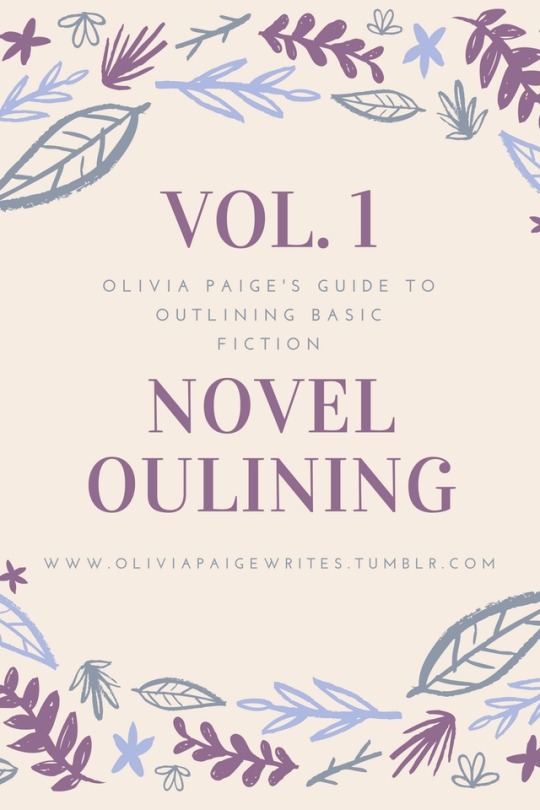
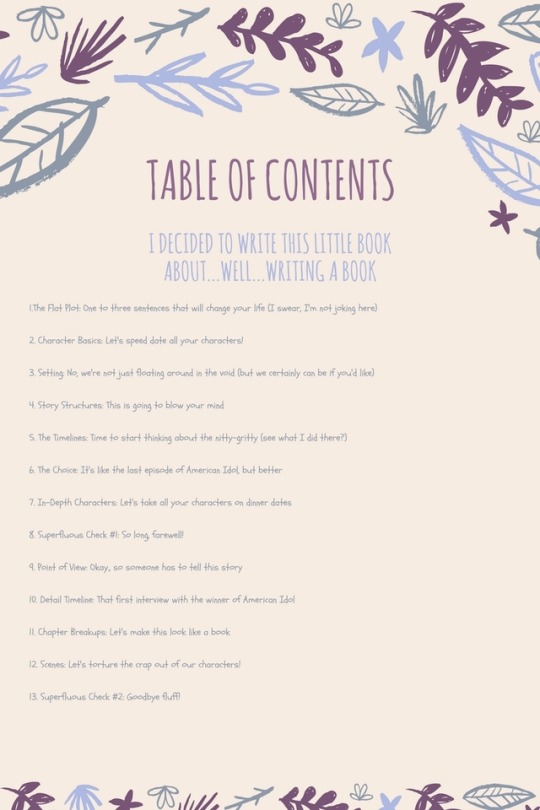
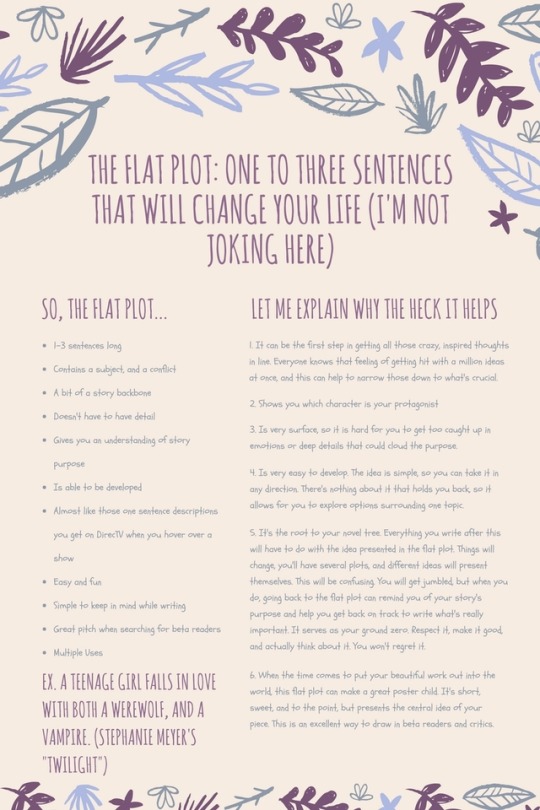
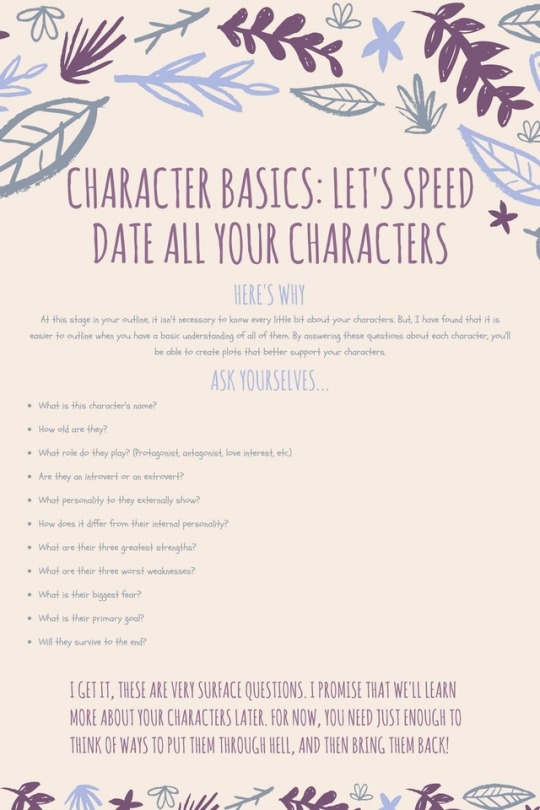
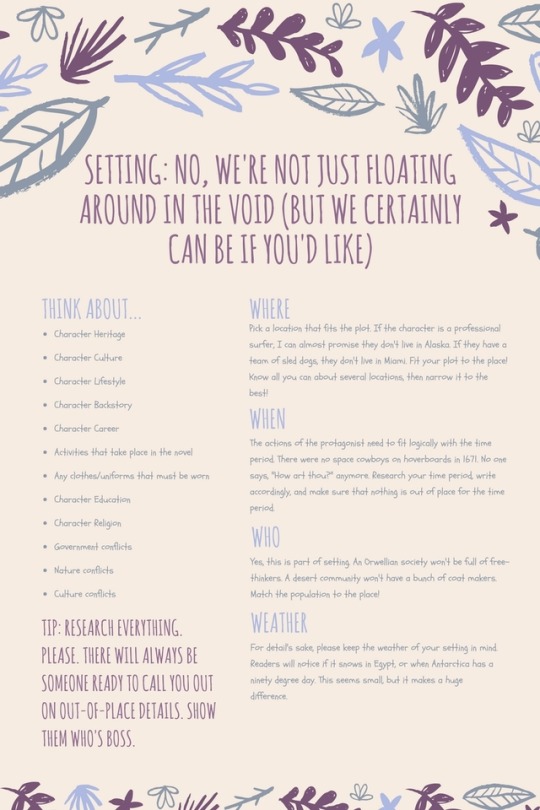
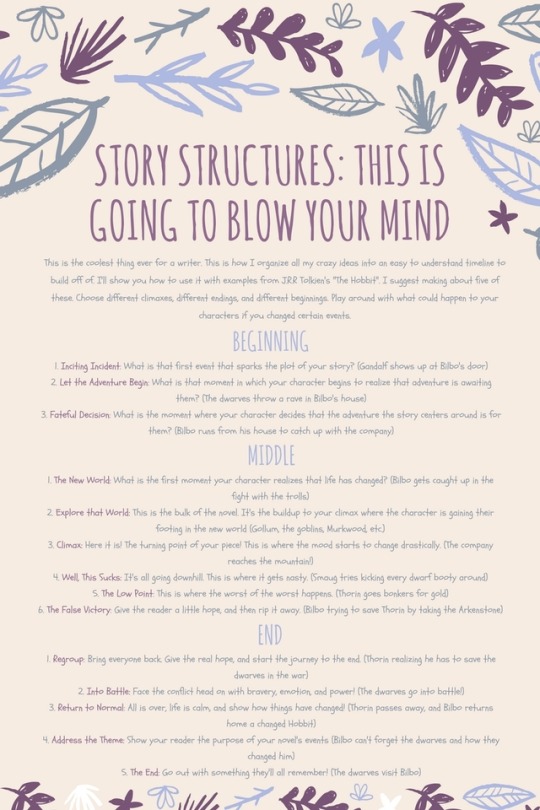
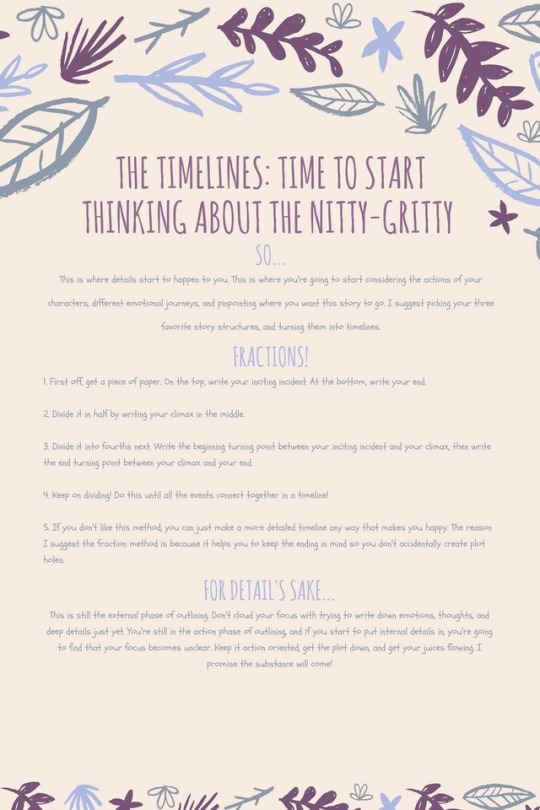
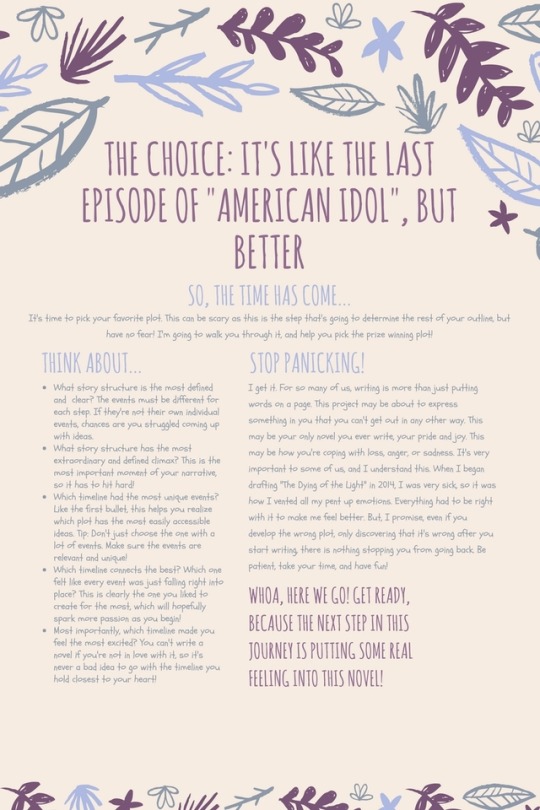
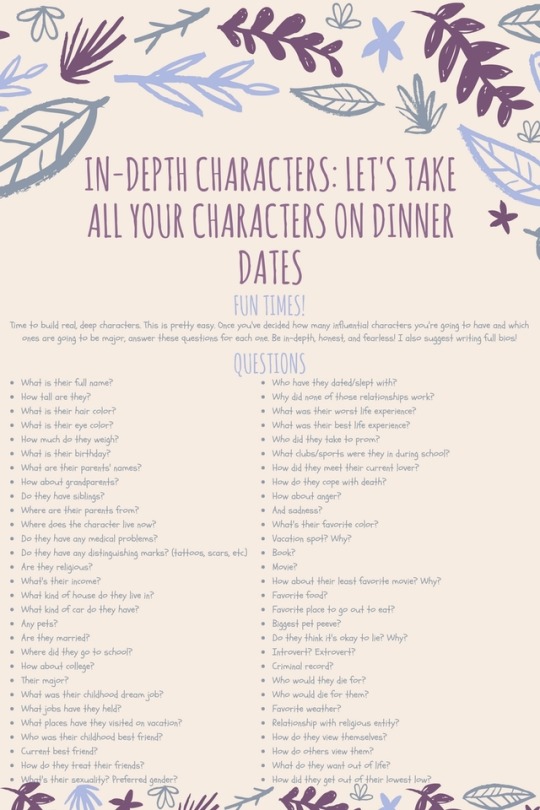
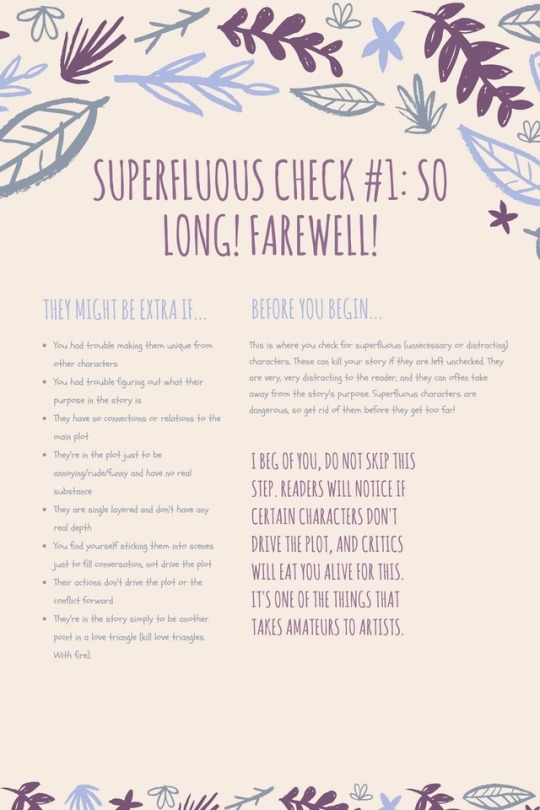
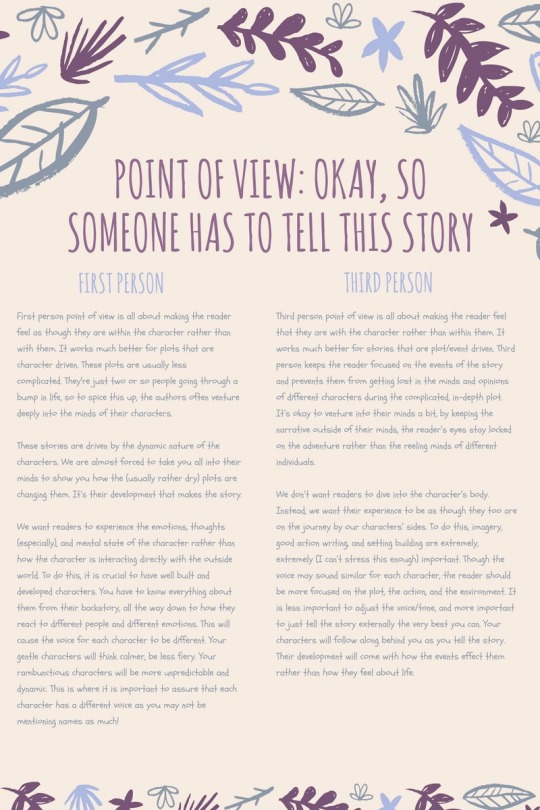
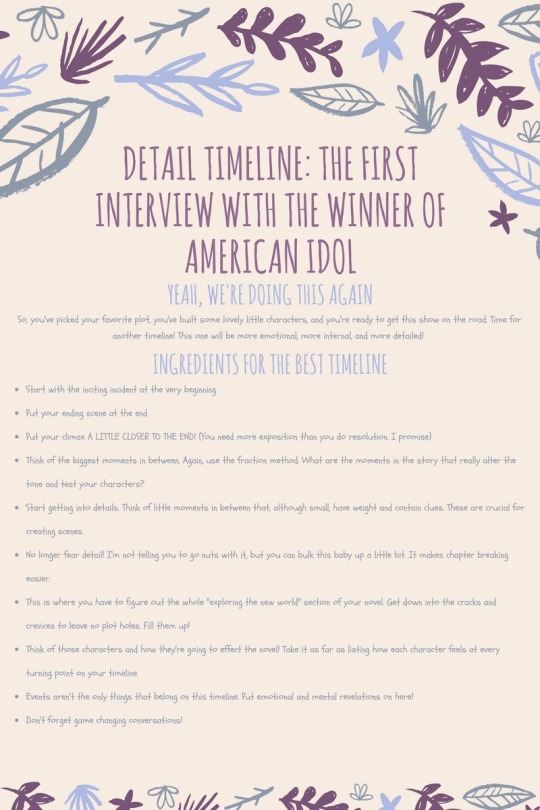
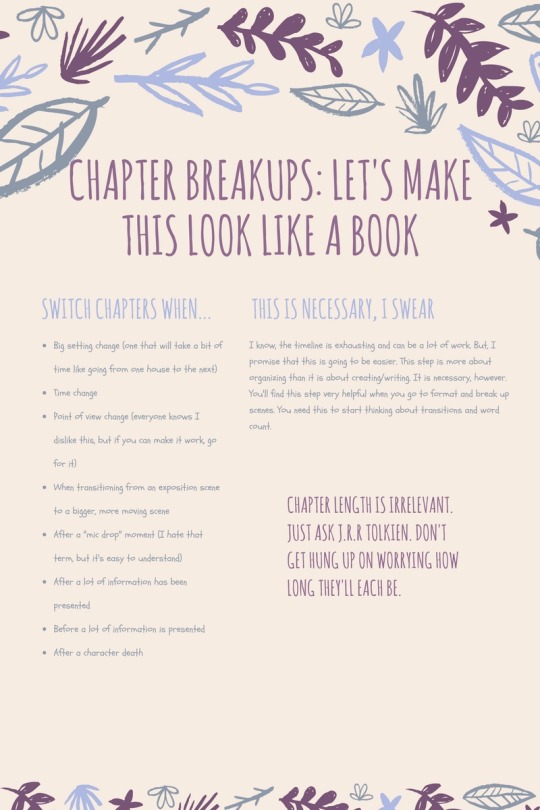
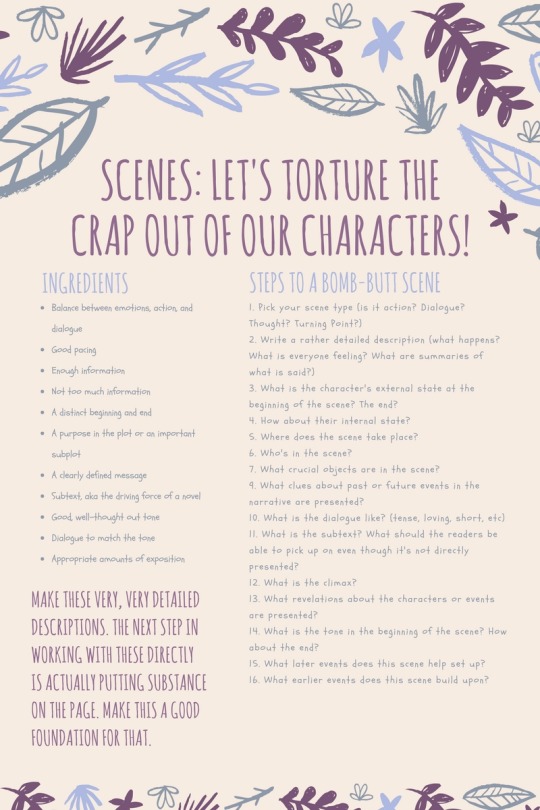
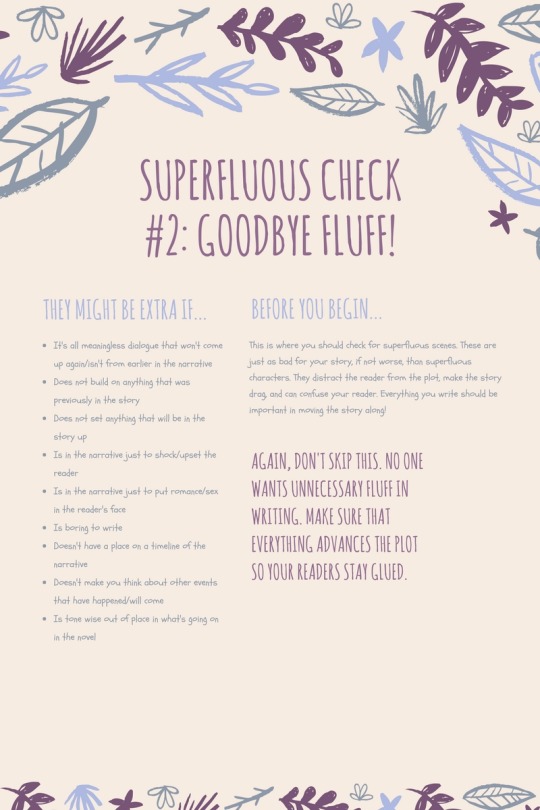
So, I heard that some of you were having issues with the download. Here’s my outlining guide just as is in photos. Same quality. Enjoy!
7K notes
·
View notes
Text
-Kinetic Abilities Prompt List A Edition
Acidikinesis - Control Sloth
I have a personal vendetta against someone wildly more successful than me so I’m trying to make them lazy.
You don’t know how to relax so I’m literally filling you with laziness but you just won’t stop.
I work at an animal shelter and I sometimes make the animals fit what people are looking for by removing or adding laziness. You haven’t lived until you saw a cat with 0% laziness.
Aciukinesis - Control Sharpness
Did you know that most man made spheres are still more jagged than the earth itself? You haven’t experienced softness until you felt a perfectly smooth ball. There’s also not a lot of traction so please cup it in your hands.
I’m one of the only chefs here that doesn’t have some sort of hot or cold ability. But me being very clumsy, the ability to make all my knives dull saves my fingers a lot.
I keep making all the knives in the kitchen blunt so I can watch my parent-in-law get frustrated and lose their dominance over me.
Aerokinesis - Control Air
I can control the air but that doesn’t do a lot so I just got a few wind turbines for my property, so I get power for free. It’s a small win, but I like it.
Sometimes I go to the beach and set up a kite rental booth while making it windy. It doesn’t make much but it helps with rent.
No one thinks that controlling air is that cool of a super power until I take it out of their lungs.
Aestatekinesis - Control Summer
I hate sweating so I made this summer really mild but it’s affecting my town’s farming economy.
I forgot that Alaska’s still supposed to be pretty cold in the summer and I may have made the ice caps melt a little more.
Aggressiokinesis - Control Anger
I work in tandem with a crisis clinic and so far, there isn’t a patient I can’t calm down.
My anti-aggression dog classes are the best in the business. I even stop by pet shelters.
I just love watching these people tear each other limb from limb with blind rage. I’m gonna be sad to see you go though.
Aidoskinesis - Control Humidity
One of the only things good about my powers is that I can make my boss’ office so humid they have horrible hair and sweat stains for their meeting with corporate.
My greenhouse is always at the perfect humidity even in the dead of winter.
I’m gulty of making someone so humid they’ve taken off their shirt before. It’s a blessing.
Alcokinesis - Control Alcohol
You always get too out of hand with your drinking so I just take the alcohol content out of your drinks.
My coworker bugs the hell out of me and they’re going in for a company-wide drug test today. I made their breakfast have a healthy amount of alcohol.
It’s very fun to see someone pantamime being drunk when they think they are when in actuality I’ve taken all the alcohol out of their drink.
Amokinesis - Control Love and Desire
Shit are you actually in love with me or did I manipulate you into liking me?
As a joke I was going to make my classmate fall in love with whoever came in next but you did and now I’m very jealous.
I make people forget about me when we break up so it’s easy on them but I can’t get rid of my own love for them, even when there’s no chance of getting back together ever now.
Anthracokinesis - Control Coal
I like being alone so I move to Centralia and just turn off the surrounding coals when I’m walking over them. It’s very quiet but very smoky. I need to leave town to buy a gas mask.
I bought a bit of land and made a little mine before buying a truckload of coal and just stiking it in the walls. Then, I compressed it all into diamonds.
So my parents gave me a little tough love as a child and gave me a piece of coal one christmas. I’ll admit, I was a naughty child. But that piece of coal made me learn of my powers. It’s the only piece I’ll never manipulate anymore.
Antikinesis - Control Antimatter
No you can’t come to my antimatter dimension. It’s very private.
I think we had a good run, I’m just gonna get a black hole in here real quick.
I always wanted to visit Chernobl, good thing I can just sort of turn off the gamma radation and go for a walk.
Argentokinesis - Control Silver
Whoops I’m in werewolf country better make all my clothes and stuff have silver mesh.
“Yes this is genuine gold” I say to someone when I took the silver content out of a ring.
So I don’t have the best impulse control. I made my rude neighbor’s prized dog into a silver statue and now it’s like… eighty sets of flatwear.
Arthrokinesis - Control Joints
I may be a very inactive person, but damned if my joints ever pop. I’m doing sprints anytime I feel like it.
I got too excited testing how much I could let my joints move and may have dislocated by shoulder.
Yes, I tried to suck my own dick. Yes, I should have realized that there is actually bone stopping me from bending my spine like that. Don’t laugh at me.
Asterokinesis - Control Cosmic Energy
I’ve ascended to be the god of the universe and all I want to do is to stop being in charge and just have some time off for once.
I saw how much earth was desperate to meet other beings so I made some closer planets support life.
I’m not just some giant being in space. I’m a regular person. I buy groceries, collect rocks, and I’m desperate for people to never know I made them.
Astrakinesis - Control Astral Energy
I am nearly constantly disassociating. The good news is that I have like thirty dream selves I can be while the others go on autopilot.
I can see spirits so I just deal with ghosts for a living. Most of the time they’re just confused.
I can work as a medium for ghosts to talk through but you roleplaying with your dead datemate is the last straw.
Astronkinesis - Control Remnants of Cosmic Substances
I realized that in my lifetime I would never see a mission to a star so I made some much closer to us.
I don’t feel like this world’s really going anywhere. I’m just gonna supernova the sun next weekend.
My tarot card readings are always perfect and I sincerely want you to leave the country.
Atmokinesis - Control Weather
I am the best weather forecaster the world has ever seen. I work for a small town in rural country though. I think I have five hundred viewers on a daily basis?
I always make sure my neighbor’s/parent’s/friend’s/etc farm gets the best weather.
My entrences are always punctuated with lightening and I love it.
Atomkinesis - Control Atoms
It’s like 3-D printing, only much better. Check out this awesome watch I made.
I hope you like nuclear wastelands, because that’s what you’re getting.
Surprise, your house is full of radon gas!it’ll stay that way until you do what I say.
Audiokinesis - Control Sound
Nothing quite like a day of absolute silence when you have an audio processing disorder.
Movies are very fun to watch when I can make one character silent and just ad lib the dialogue.
The fact that I can chat style silence someone is the best.
Aurokinesis - Control Aura
I can see how people act before ever talking to them, that’s why you’re the only one in the room I’m going to talk to.
Where I live, auras are very important. So I can easily hide among them as someone without giving an inkling of malice.
I personally hate you so now you get too radiate bad energy until you apologize.
Aurokinesis - Control Gold
I’m allergic to what they use in fake gold but I have no money for good jewelry so I just make it gold after I buy it for cheap.
It’s not quite the Midas touch, but I’ve pulled that prank before.
I make golden jewelry and sculptures by making them out of clay/wood/etc and turning them into gold for huge profits.
Autumnuskinesis - Control Autumn
My hometown capitalizes on my love of pumpkins and sweater weather by becoming a destination for those looking to beat the heat but don’t want to own a down jacket.
I can make things rot. So I rotted my neighbor’s garden a week before harvest.
I make autumn immediately follow winter so now the world’s harvesting systems are fucked because I get pollen allergies.
Avarikinesis - Control Greed
I’m trying to make the world fair by taking all the greed out of high-ranking officials but sometimes that was their only driving force and they have no actual job experience.
I made someone comically greedy because being a superhero in a town in which no banks need protecting is boring.
I want so desperately to not have to take greed out of anymore people. It’s getting so tiring. I need to go on a vacation.
Avikinesis - Control Avains
Having hawks fly to my aide when my boss was giving me shit in the parking lot was definitely a sweet move.
I may live in this cottage alone, but these birds are more than enough company. One of them just told me about someone who ate shit on pavement last week in a city ten miles away. It’s awesome.
“Bats fly, right? Why can’t I control bats?” “Please just let me do my work.” ‘What about bugs?” “Please go home.” “Do flying fish count?”
5K notes
·
View notes
Text
How to write better descriptions
1. Avoid weak words
Compare these:
He ate the sandwich
She walked towards the lake.
to these:
He devoured the sandwich
She strolled towards the lake.
Which sentences tells you more? The latter ones. Why? Because devoured and strolled are stronger words than ate and walked. They’re more specific, so they give you more information. To get across the same information with ate and walked, you’d have to add more words: ‘she walked slowly,’ ‘he ate quickly.’
Obviously this isn’t saying you can only ever use strong words–that would likely quickly devolve into purple prose–but If your descriptions only ever include general terms: ‘it smelled good’ ‘he walked over to greet her’ etc. you’re making it harder for your reader to get an accurate picture of whatever is happening in your scene.
So how do you spot a weak word? The biggest problem with (and easiest way to spot) a weak word is that it needs support from other words to really get its meaning across. If you find yourself adding adverbs and adjectives to a term, question whether or not there’s a more concise way to get your point across instead.
2. Be Specific Where Details Are Important
This isn’t to say you should describe everything in every scene in perfect detail, but being specific matters.
Which is more engaging?
He devoured the sandwich
The book smelled magical.
or
He devoured the sandwich, stopping only to lick up the melted cheese that seeped through his fingers and ran down his palm.
The book smelled like a sunlit afternoon.
Again, the latter ones. They take you into the scene. They evoke the senses. It’s the difference between telling and showing. Devoured is a strong verb, but it doesn’t give us a clear image of what is happening. Showing the character licking away the cheese gives the reader a sense of the desperation and hunger of the action. Evoking a sunlit afternoon is evoking your reader’s memories of their own sunny afternoons.These examples are statements with evidence. They provide details.
You want to invite your reader into the scene, not give them a summary of the events.
Additionally, specifics make the world feel real. They convince readers that the world actually exists. They keep the story in your readers’ minds once they’ve finished reading.
This being said, don’t pull a GRRM and describe every meal your characters eat. Some things just aren’t that important. There are MANY occasions when it’s okay to tell instead of show.
3. Remember the point of view.
Who is giving the description?
If you’re writing in 1st person or 3rd person limited, remember how your character feels about what you’re describing. If you’re describing a strawberry field, a person who was raised on a strawberry farm is going to see it differently than someone who is deathly allergic to strawberries, who is going to see it differently from a Beatles fanatic.
Maybe the Beatles fanatic is deathly allergic to strawberries and this field brings up a whole bucketful of conflicting emotions.
Which is all to say:
Good descriptions reveal character as well as scene.
If this description is coming from a character’s point of view: what is that point of view? What is this scene making your character feel? Don’t let your narrator slip away from the page.
This connects to my last point.
4. Remember why you’re including it.
Novel writing is persuasive writing. It’s an exercise in persuading your reader that your story is true, that your characters are real people. It’s an exercise in persuading your readers to feel what you want them to feel.
(There’s a well-known quote about this somewhere, but I can’t remember it exactly.)
Every description must add to the story. It should be doing something: working for some larger goal, advancing the plot, revealing character.
Maybe you’re describing a house because you want your reader to see why your character doesn’t want to move.
Maybe you’re describing this lovely-smelling book because you want the reader to know that it’s important to the character. That her favorite memories are of reading it in the attic of her grandmother’s house.
When you’re writing out a description, identify its purpose and make sure it fulfils it.
It’s okay if at first you don’t know how the house makes the character feel, or if she’s running or strolling towards the lake, or why the book is so important. Sometimes you just know it’s there. That something happened. Usually things become clearer as you write further and get to know the story and characters yourself.
Once you do know what you’re trying to say with your story, make sure you say it with every chapter, every description, and every word.
20K notes
·
View notes
Text
Resources: Master List of WQA Posts
Beginning a Story: New to Writing Advice for Teen Writers Getting Better at Writing How to Perfect Your Writing Creating the Perfect Writing Space Finding the Time to Write Beginning a Novel Figuring Out a Plot How to Give Your Story a Purpose Struggling to Get the Ball Rolling Resolving Plot Points Building a Story Off a Loose Timeline Outlining a Scene How to Tell if a Scene is Necessary Outlining and Planning a Series The Series Arc vs Each Book’s Arc Brainstorming for Ideas How to Brainstorm Finding Focus During a Storm of Ideas Turning Ideas into a Story Finding an Entry Point Into Your Story The Opening Line The Opening Scene Introducing Characters Choosing Between First and Third Person Point of View Where to Post Fiction Online Concerned About Plagiarism When Posting Story Online What is NaNoWriMo? NaNoWriMo Tips Collaborating With Another Writer Coming Up with a Title Fear of Accidental Similarities Avoiding Similarities with Other Story How Stories Are Born
Character Development: Character Authenticity Recognizing a Flat Character Fleshing Out a Flat Character Choosing a Personality Different Kinds of Antagonists Strong Female Protagonists Name Resources How to Write a Witty Character How to Write a Smart Character Tricks for Visualizing Your Character Figuring Out Who Your Characters Are Creating a Truly Evil Villain Making a “Villain Gone Good” Likable To Kill or Not Kill a Character Alternatives to Character Worksheets Finding Your Character’s Voice Keeping Character Personalities Separate and Unique Good and Bad Reasons to Kill a Character Emotionally Muted Characters Levels of Friendship How Friendships Form The Anti-Hero Casting Your Characters
Copyright: Referencing Other Works in Fiction Using Real People as Characters Fiction Based on Original Works Plagiarism & Sharing Your Story Online Acceptable Borrowing Description: How to Make Simple Writing More Vivid Describing Physical Appearance Writing Fight Scenes and Elemental Magic Horror by Daylight Horror in Darkness Describing Actions Describing Clothing and Appearance Fight Scene Resources Battlefield Scene Resources Battlefield Aftermath Avoiding the Info Dump Give Your Story a Darker Tone Weaving Details Into the Story Describing Architecture Describing Everyday Settings Describing Rooms & Buildings Writing Emotions Writing Things You Can’t Experience Showing Rather Than Telling Showing vs Telling
Dialogue: How Much is Too Much? Cutting Dialogue Down Portraying Sign Language in Dialogue Balancing Description and Dialogue Writing Dialogue Writing Accents Translating Foreign Language for the Reader Making Dialogue More Detailed Reducing Name Tagging Smooth Dialogue & Tag Help Dialogue Tags and Punctuation Dialogue Punctuation “Said” and Dialogue Tags Getting Dialogue to Flow Smoothly The Trouble with Foreign Dialogue Sounding Era Appropriate Said is Fine
Editing: Four Drafts Minimum Ways to Tighten Up Your Writing Expanding the Word Count Cutting Down the Word Count Late Stage Suggestions Different Types of Editing Getting Feedback Self-Editing After First Draft Finding a Beta Reader Finding a Critique Partner Grammar & Style: Writing Concise Sentences Three Types of Voice (also talks about writing style) Motivation: Getting Back to Writing What to Do When Your Story Stalls Moving Forward When You’ve Lost Interest (In Your Story) Finding Inspiration When You’re Stuck for an Idea Take a “Vacation” to Re-Charge Your Creativity How to Get Excited About Your Story Again Beating Writer’s Block Frustrated with Writing Quality Getting Better at Writing Staying Motivated Struggling to Get the Ball Rolling Too Stressed to Write Experiencing Enough Shushing Your Inner Editor During the First Draft Cultivating Patience The Real Value of Practice Gaining Confidence
Plot and Story Structure:
How to Develop a Plot Plot and Story Structure The Prologue Should I Cut My Prologue? What Makes a Good Prologue? Writing a Dramatic Ending Cliffhanger Endings Chapter Titles and Endings Incorporating Back Story Publishing: Where to Begin Typical Word Counts Contests, cover letters, and Query Letters Posting Novel or Sections on Blog E-Books Agents (Everything You Need to Know) Self-Publishing vs Traditional Publishing Making a Living Off Books Building a Writing Portfolio Keeping Image Private A Guide to Self-Publishing Getting Published Abroad Taking Criticism Attracting Readers on Fiction Sharing Sites Finding Readers on Tumblr Getting Stories Noticed on Wattpad How to Write a Book Blurb Age Categories: Middle Grade, Young Adult & New Adult Hard to Pronounce Author Names To Use or Not to Use a Pen Name Anonymity and Pen Names Research: Research Tips How Much Research is Enough WQA’s Guide to Internet Research Writing Things You Can’t Experience Romance: How to Avoid Forced Romantic Sub-Plot Kissing Scenes Sexual Tension Writing Romance without Experience Subtle Signs of Love Getting to Know Your Neighbor Guide to Love Triangles Delicate and Relevant Sex Scenes Love at First Sight and the Stages of Love Using Timelines to Pace Romantic Relationships Avoiding the Cheesy Stuff Friendship to Love Enemies to Lovers Building an Organic Romance
Story Elements:
Tone and Theme Suspense, Climax, and Ending Conflict and Tension Foreshadowing Symbolism Making a Point Without Tongue-Wagging Writer Responsibility Accounting for Lost Time in Scene Transitions Using Transitions to Skip TIme Scene Transitions Flashbacks Alternatives to Flashbacks Flashbacks vs Memories Writing Things You Can’t Experience Transitioning Between Action and Exposition Balance Between Exposition and Action Measuring Tension
World Building and Setting:
Establishing a Non-Traditional Fantasy Setting Creating a Fictional Calendar Naming Months in a Fictional Calendar Creating a Language Telling Time Without Clocks Going Too Far with Fantasy? Map Making Creating Religion in a Fictional World Cultural Appropriation Creating and Naming Kingdoms Setting Your Story in an Unfamiliar Place Choosing a Setting for Your Story Naming Things Setting Your Story in a Fictional Town How to Set Up an Oppressive Government
Writing Process: How I Plan Drafts Timelines Organizational Tools Budgeting Your Time
17K notes
·
View notes
Note
Hello! How would you write a dialogue in which a character is freaking out about something? I generally have them word vomit but I don't really like that style. If its too much could you show me an example as well?
Hi!
You could definitely word vomit – especially if your character is hysterical – but that’s not the only way to do it by any means. I know a few other ways.
1. Calmly.This is strange, considering your character is freaking out, but the freak-out is internal – they’re shutting themselves off due to shock. In this case, they would be quiet, sane, and even if what they’re saying is illogical, it would probably sound reasonable.
“I was right there when she shot him. He dropped like a sack of flour. I figured he was gone as soon as the bullet hit his chest. So now I’ve decided I’m gonna go after her. Right now. And I’m gonna kill her.”“What? You can’t do that!”“Sure I can. She killed him, so I kill her. It’s called justice.”“But- With just your bare hands?”“The way I feel right now, my bare hands are more than enough.”
Notice how the character who just watched their friend die in front of them isn’t yelling, isn’t stuttering, isn’t getting angry or crying – they’re perfectly calm, almost to the point of complete emotional shutdown.
2. Angrily.Some people get angry when they lose control and freak out – it scares them, and the fear manifests itself as anger. This type particularly happens when they’re upset about something and other characters aren’t taking it seriously or are shrugging off their concerns.
“No! It’s happening tonight! We don’t have time to think, or weigh things, we need to fucking leave! Now!”“We can’t. You know that, and you’d remember that, if you were thinking straight-”“I am thinking straight! It’s you who’s fucked in the head. I don’t give a damn what you think we can and can’t do, we need to clear out of here, right this second.”
As you can see, this character is freaking out – their concerns may or may not have a firm foundation, but obviously they are concerned, and that concern is manifesting itself as fury.
3. By stuttering.For some people, it’s hard to talk when they panic, because their minds race forward ahead of their mouths and they get tongue-tied. I typically see/use this with more anxious characters, or with characters who aren’t typically good at speaking anyways (in other words, who are uncomfortable with talking).
There are a couple of different ways to stutter:a. Repeat the beginning of each word.
“I tr-tried to s-save him, but he wuh-wouldn’t l-let me … he knew it was g-going to happen. It’s my f-fault!”
(However, keep in mind that this kind of stuttering is more as if you’re character is crying and trying to talk through sobs and hiccups. Please use it sparingly – it can get old fast.)
b. Repeat words.
“No. No, I don’t know what’s going on, Ricky. Ricky, why would I have any idea? Don’t fucking look at me like that, Ricky. Don’t look at me like I’m lying.”
c. Insert filler sounds: “ah”, “uh”, “um”, and/or curse words.
“I, uh, I- fuck. I,ummm, I think maybe, ah, maybe we should leave?”
For more on stuttering – it can be hard to peg correctly – check out this post.
I hope this helps! If you need anything else, please feel free to ask. - @authors-haven
6K notes
·
View notes